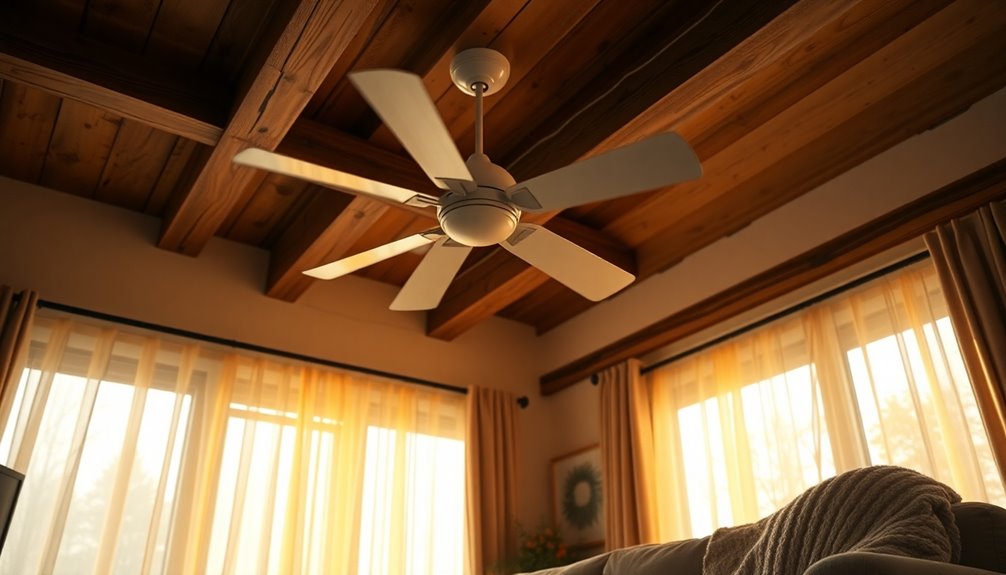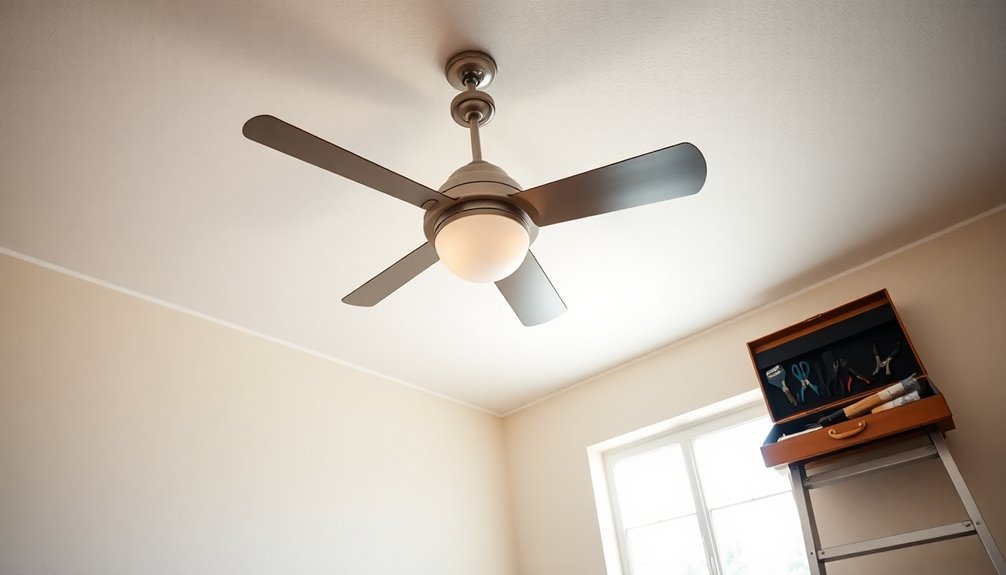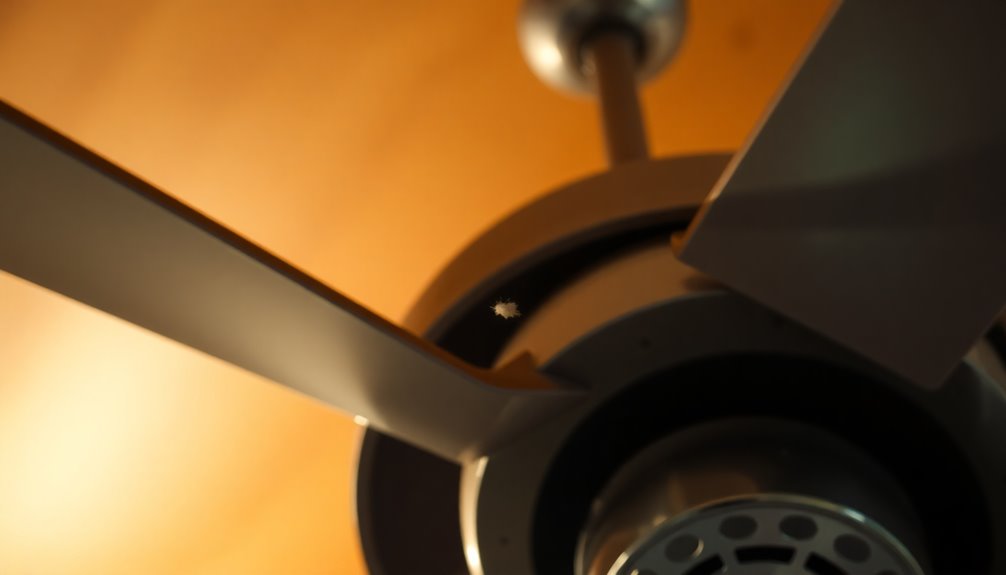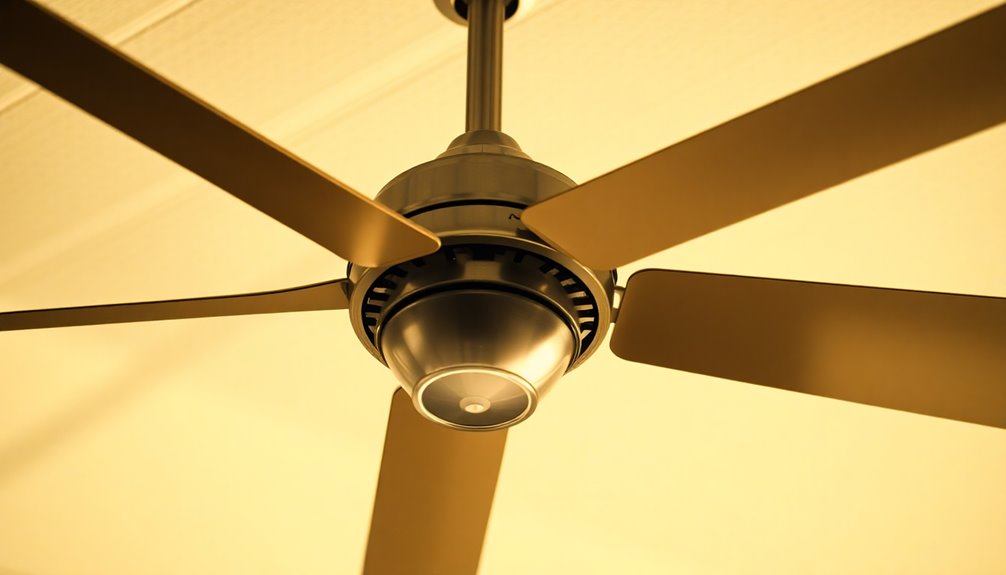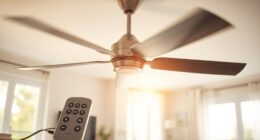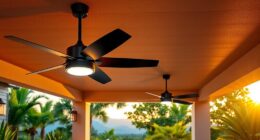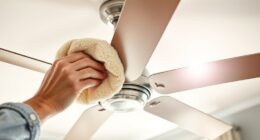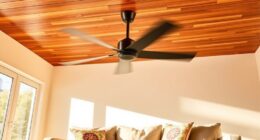In winter, you should set your ceiling fan to spin clockwise. This creates an updraft that pushes cold air up and circulates warm air down toward the floor, keeping your space cozy. By running the fan on a low speed, you can enhance comfort and even reduce heating costs by up to 15%. Just remember to turn off the fan first before changing the direction using the switch or remote. Making this simple adjustment can greatly optimize your heating efficiency, especially when temperatures drop. Stick around to learn more tips on maximizing your home's warmth and comfort this winter!
Key Takeaways
- Set your ceiling fan to rotate clockwise in winter to create an updraft and circulate warm air downwards.
- Clockwise rotation prevents drafts and reduces cold spots in your living space for enhanced comfort.
- Adjusting the fan direction can save up to 15% on heating bills by improving energy efficiency.
- Change the fan direction at the start of winter or during Daylight Savings Time for optimal warmth.
- Use low-speed operation for the fan to maintain a gentle updraft while consuming minimal energy.
Importance of Fan Direction in Winter

When winter rolls around, it's crucial to pay attention to your ceiling fan's direction. Setting your fan to rotate clockwise creates an updraft that pulls cold air upwards, allowing warm air trapped near the ceiling to be pushed down towards the floor. This simple adjustment greatly enhances your comfort during the colder months.
Running your ceiling fan at low speed in a clockwise direction can also boost energy efficiency. By maintaining a steady temperature, you can reduce heating costs by up to 10%, meaning you won't have to rely as heavily on your heating system.
You'll find that comfortable indoor temperatures can be achieved while allowing for lower thermostat settings.
Most ceiling fans come equipped with a ceiling fan switch that lets you easily reverse the fan's direction. This feature is typically located near the fan base, making it convenient to adjust as the seasons change.
How to Change Fan Direction

To change your ceiling fan's direction for winter, start by turning it off and letting it come to a complete stop for safety.
If you have a ceiling fan with a pull chain, locate the reverse switch on the fan body. Pull that switch to change the fan direction to clockwise.
For remote-controlled fans, make certain your remote is paired, turn off the fan, and press and hold the fan button until you see a light blinking. This indicates that the direction has been successfully changed to clockwise.
If you own smart fans, you can easily adjust the direction using compatible mobile apps or voice commands. This makes switching to clockwise rotation for winter a breeze.
Once you've changed the direction, don't forget to turn the fan back on at a low speed. This will guarantee warm air circulates downwards, making your space more comfortable.
By following these steps, you'll keep your ceiling fan energy efficient and maximize its effectiveness during winter months.
With the right adjustments, your ceiling fan can make a significant difference in your home's warmth and comfort.
Benefits of Clockwise Rotation

Changing your ceiling fan's direction to clockwise for winter offers several advantages that can enhance your home's comfort. By creating an updraft, the clockwise rotation pulls cold air upwards and pushes warm air down towards your living space. This helps distribute heat evenly throughout the room, reducing cold spots and maintaining a cozy environment.
| Benefit | Description |
|---|---|
| Updraft | Pulls cold air up, allowing warm air to circulate. |
| Energy Savings | Low speed operation can save up to 15% on heating bills. |
| Heat Distribution | Guarantees even warmth, enhancing overall comfort. |
| Comfort | Prevents drafts that can come from higher speeds. |
| Easy Adjustment | Use the reversing switch to quickly change direction. |
With your ceiling fan set to low speed, you'll enjoy the gentle updraft that enhances warmth without creating discomfort. Not only does this setting optimize your heating needs, but it also allows you to lower your thermostat, leading to notable energy savings. Embrace the benefits of clockwise rotation and enjoy a more comfortable winter season in your home.
Timing for Direction Adjustments

Adjusting your ceiling fan's direction at the right time is essential for maximizing comfort and energy efficiency during winter.
To guarantee you're making the most effective adjustments, consider these key timing strategies:
- Daylight Savings Time: Change the ceiling fan direction during the shift to winter, specifically when you "fall back." This serves as a helpful reminder to adjust your fan to clockwise, which will circulate warm air effectively.
- Early Winter Adjustments: Set your fan to rotate clockwise at the beginning of winter. This will help maintain a cozy indoor temperature while allowing you to lower your thermostat settings, leading to energy savings.
- Preemptive Changes: Make certain your ceiling fan direction is adjusted before significant drops in temperature.
This proactive measure can contribute to energy savings of up to 10% on your heating costs.
Energy Savings From Proper Use

Making sure your ceiling fan runs in the right direction during winter can lead to significant energy savings. When you set your fan to spin clockwise, it creates a gentle updraft that pushes warm air, which collects near the ceiling, back down into the room.
This simple adjustment can save you up to 15% on heating bills by redistributing warm air more efficiently. By maintaining a consistent temperature without drafts, you'll feel more comfortable and can lower your thermostat settings by about 4 degrees Fahrenheit.
That's a smart way to cut costs! Plus, ceiling fans are energy-efficient, consuming only 15 to 90 watts, whereas traditional heating systems can use thousands of watts.
This means that while the fan blades are spinning gently, you're optimizing your heating system and reducing your reliance on costly heating methods.
Frequently Asked Questions
How Can You Tell if a Fan Is Going Clockwise or Counterclockwise?
To tell if your fan's spinning clockwise or counterclockwise, stand directly underneath it.
If you feel a gentle updraft of warm air, it's moving clockwise. Alternatively, if you notice a noticeable breeze, that means it's spinning counterclockwise.
You can also check the blade movement: clockwise blades will seem to move from the top right to the bottom left.
If you're unsure, use the reversing switch or your fan's app for confirmation.
What Direction Do I Rub My Ceiling Fan in the Winter?
You wouldn't believe how much a simple ceiling fan can change your winter experience!
To maximize warmth and comfort, you should set your fan to spin clockwise. This magical motion creates an updraft, pushing the warm air down where you need it most.
Just flip that reversing switch, and you're good to go! Running it on low speed keeps the cozy vibes flowing without any chilly drafts ruining your winter bliss.
What Is the Best Ceiling Fan Setting for Winter?
To optimize your comfort during winter, set your ceiling fan to rotate clockwise at a low speed.
This creates an updraft that pushes warm air down into your living space, enhancing warmth without creating drafts.
You'll notice a gentle breeze when standing beneath it, confirming effective heat distribution.
Do Ceiling Fans Make a Difference in Winter?
Do ceiling fans really make a difference in winter? Absolutely!
When you run your ceiling fan in the right direction, it helps circulate warm air that rises, keeping your space cozy and comfortable. By using the fan on a low setting, you can evenly distribute heat throughout the room without creating drafts.
This simple adjustment can save you money on heating costs while maintaining a pleasant indoor environment. It's a smart, energy-efficient choice!
Conclusion
So, as the winter chill sets in, remember to switch your ceiling fan to spin clockwise. This simple adjustment helps circulate warm air that rises, keeping your space cozy without cranking up the heat—like finding a hidden treasure in your attic! By using your fan wisely, you'll not only stay comfortable but also save on energy costs. It's a win-win! Don't let winter catch you off guard; make that change today and enjoy the warm vibes all season long.
